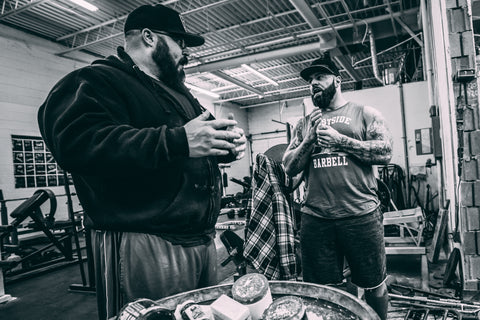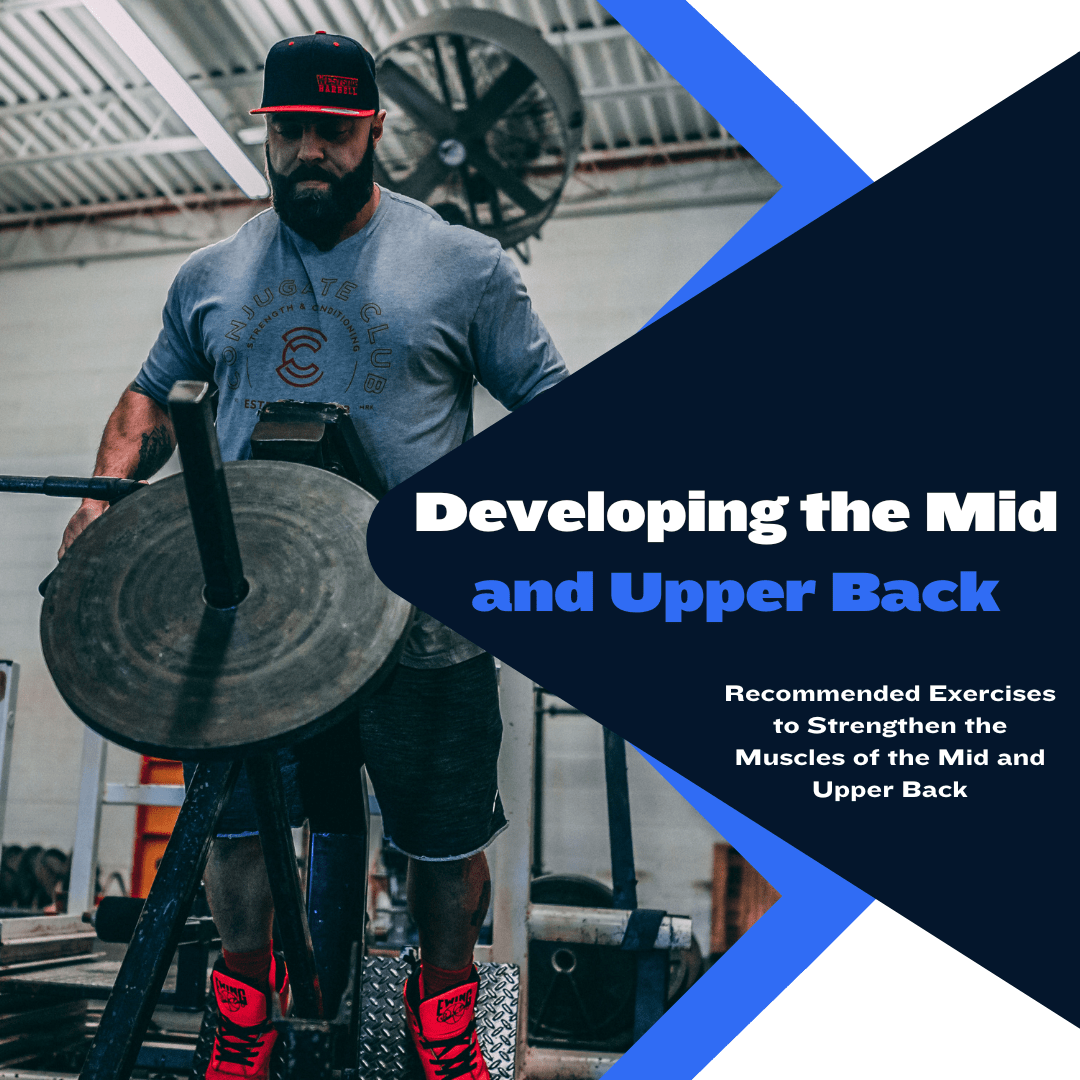Starting Conjugate: Developing the Mid and Upper Back

The development of a strong posterior chain is a necessity for all athletes. Whether an athlete is focused on strength or conventional sports, a strong posterior chain will increase force output, improve stability, and enhance durability. A critical aspect of posterior chain development is strengthening the muscle groups responsible for supporting the spine.
Improving the strength of these muscle groups allows an athlete to resist excessive spinal flexion, resulting in improved nerve conduction and a lower risk of injury. It is a simple concept; a strong back keeps the spine protected and in an advantageous position to achieve high levels of force output. If the back muscles are weak, the spine will experience excessive flexion, leading to diminished nerve conduction and a loss of athletic capabilities.
Keep in mind that flexion in the spine is not a bad thing. Spinal flexion is expected in strength sports where max effort lifts are commonplace. The goal is to remain within acceptable flexion ranges, allowing an athlete to maintain optimal torso positioning throughout the lift. To ensure an athlete has the capacity to resist excessive flexion, we must train the back properly.
When training to resist excessive spinal flexion, an athlete must improve the strength of the mid and upper back. The squat, bench, deadlift, overhead press, and many other common lifts place great demand on these muscle groups. A strong mid and upper back will improve capabilities during exercise or competition, and the risk of lumbar injury will also be reduced. If the mid and upper back can do their part, less stress will be placed on the lumbar spine.
Below, we will review a few of the go-to exercises we use at Westside Barbell to ensure the mid and upper back are trained appropriately and the spine is adequately protected.
Barbell Rows
The barbell row is one of the best ways to target the mid and upper back, allowing an athlete many options regarding training volume and intensity. Unlike cable machines, where the training weights are limited depending on the weight stack, the barbell row allows an athlete to load up as much weight as needed to achieve optimal levels of training intensity.
At Westside, we perform barbell rows using two styles: powerlifting and bodybuilding. A powerlifting style row is more concerned with training intensity and strength development. This style of barbell row allows for a bit more body English than the typical row, which is why this style of row is also referred to as “cheater rows.”
The intent here, of course, is not to cheat but to increase the training load without being constrained by the strict technique applied during bodybuilding-style rows.
When performing powerlifting-style rows, we typically program the movement as a primary accessory exercise executed immediately after the main exercise. This helps to ensure an athlete has the energy levels necessary to safely complete the exercise at an optimal level of training intensity. Most often, the volume prescription is 3-5 sets of 5-8 repetitions, using the heaviest weight an athlete can reasonably tolerate while executing all repetitions with acceptable technique.
Bodybuilding-style rows are also commonly used. However, unlike powerlifting-style rows, our intent here is strict and controlled execution. The training focus is also a bit different. Instead of being solely concerned with improving strength, we use the bodybuilding row to achieve worthwhile mid and upper-back hypertrophy.
When executing bodybuilding rows, we typically perform 3-5 sets of 8-10 or 10-12 repetitions. We will choose a training weight that provides meaningful stimulus while allowing the strict technique to be maintained.

V Bar Pulldowns
The V bar pulldown is a great way to train the mid and upper back. This exercise primarily focuses on developing the lats while also targeting the trapezius muscle and the posterior shoulders. If you are an athlete who believes your mid and upper back strength is hindering your bench press progress, the V bar pulldown is a movement you should perform regularly.
When performing a V bar pulldown, we want to focus on strict execution. Often, during an exercise such as lat pulldowns, athletes become lax in their execution, creating momentum and rendering the training less effective. With the V bar pulldown, we want to properly brace the trunk, achieve a “chest up” position, and use the mid and upper back muscles to move the weight.
Programming this exercise is simple. We typically perform 3-4 sets of 8-10, 10-12, or 12-15 repetitions.
Chest-Supported Rows
The chest-supported row is another excellent way to develop a strong mid and upper back. Unlike the barbell row, where an athlete must properly brace to ensure the torso remains in proper position, the chest-supported row provides stability to allow an athlete to focus specifically on the targeted muscle groups. This positioning also helps to ensure an athlete cannot “cheat” the lift, considering torso movement is restricted by the chest pad.
At Westside, we perform chest-supported rows in both an upright seated and leaned position. No matter which positions the torso is in; the focus remains the same - strict execution of each rep with a focus on the mid and upper back. Additionally, we can manipulate grip positioning to emphasize the mid or upper back.
If we go with the typical grip positioning, a significant burden is placed on the mid back, with the upper back also playing a role. However, if we change to a close grip, we can specifically focus on the upper back and posterior shoulders. We often alternate grips from set to set to ensure the mid and upper back are taxed appropriately.
When programming chest-supported rows, we typically perform 3-4 sets of 8-10, 10-12, or 12-15 repetitions.

Close Grip Pull-Ups
Bodyweight exercises can also be a great way to target the mid and upper back. The close grip pull-up will place significant emphasis on the upper back and posterior shoulders, providing tremendous benefit without significantly affecting recovery. This exercise is a great way to finish up an upper body training day to ensure the mid/upper back, posterior shoulders, and arms are properly trained.
When executing close grip pull-ups, we want to use a pronated grip, focusing on strict form. Like the bodybuilding row or V bar pulldowns, we want to avoid using excessive body English to create momentum. The focus should be on strict pulls, emphasizing the use of the mid and upper back to complete each rep.
Ideally, we want to pull until the nose/chin reaches the level of the pull-up bar, with a controlled descent allowing the arms to extend fully. Programming this exercise is simple. We will typically perform 3-5 sets, executing as many reps as possible in each set. If an athlete finds bodyweight pull-ups too easy, we can add hanging weight from a belt. If an athlete struggles to perform pull-ups, we can attach a band to the rack underneath the feet to assist.
Never Neglect the Back
Whether an athlete is just beginning to train or is one of the strongest athletes in the world, back training should always be addressed. No matter the sport or barbell lift, a strong back will ultimately improve sports performance and increase durability and resilience. There is no such thing as a back that is “strong enough.” We must continuously focus on strengthening the back muscles.
The exercises listed above are great ways to focus on developing the mid and upper back and will help to improve spine stabilization. When you think of a missed squat or deadlift, the cervical and thoracic spine are typically the first to give, resulting in excessive demand placed on the lumbar spine. At best, this will result in a missed lift. At worst, this results in a lumbar spine injury.
By improving the strength of the muscle groups responsible for supporting the cervical and thoracic spine, an athlete can resist excessive spinal flexion. This will reduce the risk of injury to the spine and result in greater force output, considering nerve conduction is not hindered by excessive spinal flexion. Much like a pinched garden hose cuts off water flow, excessive spinal flexion reduces nerve conduction.
If an athlete wants to become capable of producing high levels of force output under demanding conditions, the back muscles must be properly trained. When the back is properly trained, sports performance improves, and spinal injury rates decline. Do not fear reasonable spinal flexion; become strong enough to tolerate it.
Sources:
Simmons, L. (2007). Westside Barbell Book of Methods. Westside Barbell.
Verkhoshansky, Y., & Siff, M. C. (2009). Supertraining. Verkhoshansky.
Zatsiorsky, V. M., & Kraemer, W. J. (2006). Science and Practice of Strength Training. Human Kinetics





